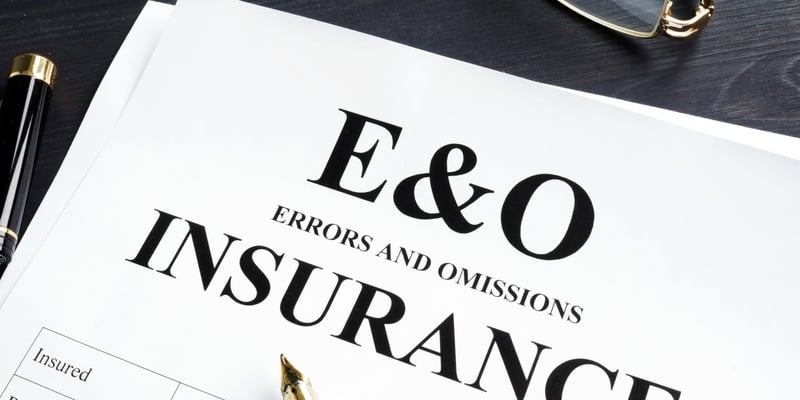Errors and Omissions Risk Management for New Life Insurance Agents
Jun 29, 2023 | 6 MIN READ
Being a life insurance agent can be a lucrative line of work, but it means putting in the hours as well. As with any professional service that involves client finances, it’s important to make sure that the paperwork you submit is as accurate and complete as possible. Managing errors and omissions risks can be tedious work, but it’s incredibly helpful for enabling your continued success as a life insurance agent.
What are errors and omissions (E&O) risks? Why is it important to manage them? Most of all, what can you do as a new or independent insurance agent to mitigate E&O risks in your life insurance policies?
What Are Errors and Omissions for Life Insurance Agents?
Errors and omissions in life insurance are exactly what they sound like: mistakes or missing information in the paperwork surrounding a life insurance policy, such as the certificate of insurance (COI) document summarizing the important details of the policy.
As a new life insurance agent, it’s easy to underestimate the risk of errors and omissions in routine paperwork. However, given the sheer amount of documentation that exists in any insurance agreement and the existence of several parties of interest, it’s important to keep track of all related factors. This includes the insured, the policy owner (who may or may not be the insured person), the beneficiary (or beneficiaries), the insurance company, you (as an agent), and the insurance broker.
Additionally, in many life insurance policies, you may also have the underwriter and a medical examiner involved as well to assess the level of risk that the insured person poses.
With paperwork passing between all of these parties, it’s all too easy for any one of them to make an oversight that leads to an inaccuracy or a piece of paperwork missing important information.
For example, say that you provide a coverage summary to a client for a whole life policy based on a template. For years, the terms of this particular insurance product have remained the same, so you (or your team or a third-party contractor) fill out the summary the same as always. However, the insurance company recently changed some of the terms in their insurance policy.
Now, the summary document doesn’t quite match the terms of the actual insurance contract, but the client doesn’t know since they only ever read the summary and not the much longer, more complicated contract agreement. Eventually, this causes problems such as the insurance company believing the client to be in breach due to insufficient payments, failing to provide a death benefit matching the amount specified in the summary, or other issues.
After a careful review of the insurance contract and the summarizing document provided to the policy owner, you realize that there’s a discrepancy. The issue is that the summary isn’t the contract and doesn’t modify the contract, but it does set the client’s expectations of the contract.
So, errors and omissions in this summary can have a severe negative impact on the client’s experience with the insurance company and with you as a life insurance agent.
Two Common E&O Costs
What are the potential costs of errors and omissions that make E&O risk management so vital for insurance agents? Some of the potential costs of life insurance policy errors include, but may not be limited to:
Reputational Damage
Frequent problems with insurance contracts arising from errors and omissions can be devastating to an insurance agent’s (or a brokerage’s) reputation. As negative reviews and complaints with regulators accumulate, new insurance customers may be put off of working with the agent.
This reputational damage can be crippling to an agent’s long-term success because of how it impacts their marketing efforts. While a single mistake here or there can be dealt with if you’re proactive and work to protect your clients, repeated errors can bring even the biggest brokers and agents down.
Financial Costs
If a client is impacted by an error or omission in their insurance documents, odds are that you’ll want to make things right for them as quickly as possible. This may mean providing compensation to the client to help make them whole for the misunderstanding created by an error or omission.
Additionally, if you find yourself in a legal dispute, the cost of an attorney to defend your case can be astronomical. Estimates for defending a lawsuit vary due to a wide range of circumstances, including the complexity of the case, the individual attorney’s fees, and the duration of the case.
However, costs in the tens or even hundreds of thousands of dollars are fairly common. As noted by Thumbtack, “larger, more powerful firms with in-demand attorneys may charge as much as $500 per hour.” Add to this various court costs for filing motions, creating copies of documents, filing appeals, and a potentially years-long timeline, and the cost of a civil suit can skyrocket.
Ways to Manage Errors and Omissions Risks
Any one of the issues listed above would be a good reason to engage in strict E&O risk management. The question is: “How can you manage your E&O risks effectively?”
Here are a few ideas on mitigating errors and omissions risks in your life insurance sales efforts.

Acquire E&O Insurance
Errors and omissions insurance is a type of liability insurance product for businesses that is designed to help cover costs arising from, as noted by Investopedia, “errors, mistakes, or oversights incurred during the course of work” as well as “professional negligence.”
This includes, for example, court costs arising from E&O-related lawsuits and possibly even the cost of an E&O settlement. With an E&O policy in place, you can mitigate the financial impact of a life insurance contract dispute arising from an error in the paperwork or sales process.
How much does errors and omissions insurance cost? The answer is: “It depends.” The larger your agency, the higher the coverage amount, and the greater the risk the insurance company assumes for providing insurance, the more E&O insurance will likely cost you.
In case you were wondering, agents working with ELCO Mutual will need to have at least $1 million in liability coverage to be contracted with our company. We partner with NAPA on private-label E&O for life insurance agents.
It’s important to shop around and get multiple quotes for E&O insurance before settling on one policy.
Establish Strong Communications with Life Insurance Companies
Being intimately familiar with the particulars of each insurance product you offer to your clients is key for avoiding E&O risks in your business. While it can be difficult to keep up with all of the updates that insurers make to their policy contracts, establishing strong communications is important.
Having a policy in place to review any updates from insurance companies regarding new products or changes to their existing products not only helps you avoid making misrepresentations to clients, but it can also make you a more effective insurance agent. With deeper knowledge of the company’s products, you can more easily answer client questions and identify the best products to meet their needs—providing a more positive insurance acquisition experience.
Add an Insurance Contract Review Process
Consider adding a review process for each of your insurance contracts where you, another insurance agent, or a team of assistants review each contract and related documents for missing or incorrect information. Having multiple sets of eyes on an insurance contract can help reduce the risk of errors and omissions.
Furthermore, it may help to acquire software that can review contracts for major omissions or inconsistencies which could cause issues. If necessary, create a checklist of common errors or omissions for reviewers to go through and verify step-by-step.
Partner with a Reliable Company
As an independent agent, it can be hard to gather the personnel and resources you need to maximize your insurance sales while minimizing your risks.
Joining an established community of life insurance agents who have been in your shoes backed by a company that provides service, stability, and protection can be incredibly beneficial for new life insurance agents.
In particular, it helps to find a partner that is willing and able to provide you with continuing education that helps keep you at the top of your game in the insurance industry. This helps you keep up to date with new regulations and changes to insurance products so you’re less likely to run afoul of mistakes caused by not knowing new rules or if a major change was made to a popular life insurance product.
Are you ready to join a community of life insurance agents of all skill levels? Need help achieving greater success as an insurance agent? Reach out to ELCO Mutual today to get started!
